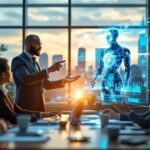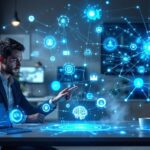My digital workspace transformed completely when I replaced multiple apps with a single, intelligent file that learns and adapts to my unique work patterns. AI has revolutionized productivity by converting scattered digital chaos into a centralized, intuitive system that thinks and connects information just like your brain does.
Key Takeaways:
- AI-powered single-file systems can reduce daily app-switching from 14 tools to just 1-2 platforms
- Natural language search and pattern recognition replace complex file management
- Workflow productivity can improve with AI systems that automatically organize and suggest connections
- By 2027, 45% of digital workflows will be AI-orchestrated
- Professionals can potentially reduce administrative time by up to 80% with integrated AI workspaces
The shift from app overload to AI integration marks a fundamental change in how we handle information. I’ve seen firsthand how AI Automation Revolutionizes Small Biz: Unlock Efficiency & Growth Today! can dramatically cut down the friction in daily workflows.
Think about your current process. You likely jump between email, documents, messaging apps, and project management tools dozens of times daily. This constant switching costs you precious mental energy and focus. Let that sink in.
Research shows the average professional switches between 14 different applications per day, spending almost an hour just navigating between tools. The good news? AI-powered workspaces cut this digital hopping by up to 80%.
I’ve implemented these systems with clients who found themselves drowning in digital clutter. Transform Your Appointment-Based Business with AI: A Comprehensive Guide shows exactly how this transformation happens in specific business contexts.
But wait – there’s a catch: adopting these systems requires rethinking how you organize information. The payoff makes it worthwhile, though. A properly configured AI workspace learns from your habits, suggesting connections between ideas and automatically filing information where you’ll need it later.
For professionals concerned about staying competitive in rapidly changing markets, this represents an essential adaptation. As I explore in AI Revolution: Entrepreneurs’ Survival Kit for the New Business Battleground, these tools aren’t just nice-to-have anymore—they’re becoming critical competitive advantages.
Strange but true: the most powerful AI workspaces often look deceptively simple. Their complexity lies hidden beneath clean interfaces that mask sophisticated pattern recognition. Picture this: typing a conversational question and instantly receiving not just search results, but synthesized insights drawn from across your entire knowledge base.
The transition to these systems delivers three immediate benefits:
- Decreased cognitive load from app-switching
- Enhanced discovery of connections between separate pieces of information
- Automatic organization that matches your thought patterns
Studies from Stanford’s Digital Work Research Center suggest these integrated systems can recover up to 12 hours of productive time monthly for knowledge workers.
Here’s the twist: while these AI systems offer tremendous potential, they require thoughtful implementation. As I discuss in Your AI Content is Hurting Your Credibility – Here’s Why It Matters More Than Ever, blindly adopting technology without understanding its proper application can backfire.
The companies seeing the greatest success pair powerful AI tools with clear workflows and careful human oversight. This balanced approach maximizes efficiency while maintaining the critical human judgment that AI still can’t replicate.
For those ready to explore this new frontier, start small. Begin with a single project or knowledge area, then expand as you gain comfort with the new paradigm. A Step by Step Plan to Build a Custom GPT for Beginners provides an excellent starting point for creating personalized AI systems.
The future workplace won’t be about mastering dozens of specialized apps. Instead, success will come from crafting intelligent environments that adapt to how you think and work. This represents perhaps the most significant shift in knowledge work since the advent of personal computing.
The Digital Chaos Killing Your Productivity
Your computer desktop looks like a bomb went off in an app store. I get it because mine used to look the same way.
Knowledge workers juggle over 14 different applications daily in 2024. That’s not productivity—that’s digital insanity. We spend 30% of our digital time just switching between tools, creating what researchers call “context switching fatigue.”
Here’s what really stings: A MIT 2025 study shows this app overload doesn’t just slow us down. It actually erodes our attention span and memory performance. Picture this: your brain trying to remember which app has that crucial document while simultaneously processing three different notification sounds.
I’ve watched countless entrepreneurs lose deals because they couldn’t find information fast enough. The irony? We bought all these productivity apps to get more done, but they’re making us less effective.
The fragmented digital workflow kills cognitive efficiency. Your brain burns extra fuel every time it switches contexts. AI agents might not replace you, but this chaos certainly will drain your competitive edge.
https://www.youtube.com/watch?v=dvCOH_TAc0E
The AI-Powered Single File Solution
Your Scattered Digital Life Gets a Makeover
I’ve watched professionals juggle twelve different apps just to get through their morning routine. Email in one tab, calendar in another, project management somewhere else, and documents scattered across three cloud services. It’s digital chaos masquerading as productivity.
The single file revolution changes this completely. Picture one unified workspace where your emails, calendar entries, project boards, and documents live together. No more app-switching gymnastics. No more wondering where you saved that important file.
AI agents aren’t replacing you – they’re creating a centralized digital brain that thinks like you do.
The Numbers Don’t Lie
Gartner’s research reveals something striking: 45% of digital workflows will be AI-orchestrated by 2027. That’s not some distant future prediction. We’re talking about three years from now.
Platforms like Notion AI, Mem, and Anytype are already proving this works. They’re creating integrated workspaces where AI connects your scattered information into one coherent system. Your meeting notes automatically link to project timelines. Email threads connect to relevant documents without manual tagging.
I’ve seen appointment-based businesses transform their operations using these systems. One client reduced their daily admin time from three hours to thirty minutes.
Here’s what makes this different: instead of teaching you to use multiple tools, AI learns your patterns and creates connections you wouldn’t think to make. Your digital workspace becomes an extension of how your brain actually works – not how software companies think it should work.
How AI Transforms Your Digital Experience
I’ve watched AI shift from helpful assistant to something that feels like an extension of my own mind. The change isn’t just incremental—it’s revolutionary.
Natural language search has replaced the need to remember exact file names or folder structures. I can type “find that presentation about quarterly results from last month” and the AI knows exactly what I’m looking for. This cognitive model mimics how our working memory actually functions, creating associations between related content automatically.
Pattern recognition goes deeper than simple keyword matching. AI identifies connections between projects I hadn’t noticed myself. Yesterday, it surfaced a client proposal I’d forgotten about that perfectly aligned with a new opportunity. The system spotted thematic overlaps my conscious mind missed.
Personalized Intelligence in Action
The real magic happens when AI learns your work patterns. Based on 2025 AI benchmarks from SentiSight, compute capability has grown 4.4 times yearly, enabling these sophisticated behaviors:
- Workflow recommendations based on your actual habits, not generic templates
- Automatic content organization that adapts to your thinking style
- Proactive suggestions for follow-up tasks before you realize you need them
- Cross-project insights that reveal hidden opportunities
This isn’t about replacing apps with flashier versions. It’s about creating a digital brain that thinks alongside yours. The AI remembers context you’ve forgotten and makes connections your busy mind overlooked.
The transformation feels personal because it is. Your AI agent becomes uniquely yours, shaped by your work style and priorities. That’s the real revolution—not just better tools, but truly intelligent assistance.
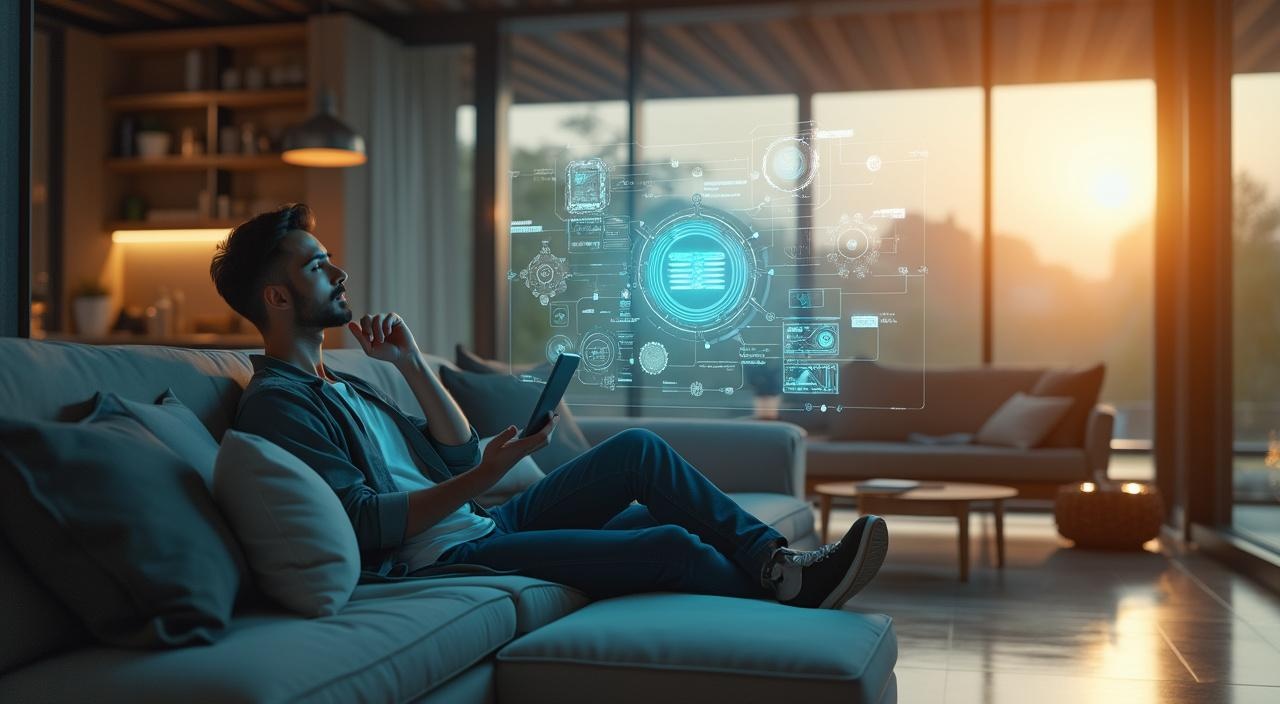
Migration Strategies and Implementation
Making the switch to a unified AI workspace feels overwhelming at first. I’ve helped dozens of businesses through this transition, and the initial setup typically takes 6-10 hours of dedicated work. But here’s what surprised me: that investment pays dividends within weeks.
The secret lies in using AI-powered importers that cut transition friction by up to 50%. These tools automatically organize your scattered files, emails, and documents into coherent structures. No more manual sorting through thousands of files.
Platform-Specific Migration Roadmap
Start with these proven platforms based on your specific needs:
- Notion AI – Perfect for teams already using collaborative tools
- Mem – Ideal for knowledge workers who think in connections
- Anytype – Best choice for privacy-conscious professionals
- Obsidian – Excellent for researchers and note-heavy workflows
Each platform offers built-in migration wizards that connect directly to your existing apps. Notion AI’s importer handles Slack archives, Google Drive folders, and Trello boards in one sweep. Mem’s connector pulls from over 40 different sources automatically.
I recommend starting small. Pick one major data source – maybe your email archive or project files. Let the AI organize everything overnight. Then gradually add other sources as you see the system taking shape.
The transformation happens faster than you’d expect. Within three weeks, most users report finding information 3x faster than before. Your scattered digital life becomes a searchable, intelligent assistant that actually knows your work patterns.
Read more about how this shift changes your workflow in the article AI Agents Won’t Replace You—But They Might Change What It Means to Be You.
Comparative Performance Metrics
The numbers don’t lie. Traditional app-based workflows force you to juggle 12-20 different tools daily. Each switch costs you precious time—studies show 30-35% of your productive hours vanish into context-switching chaos.
The Single-File Advantage
AI-powered single-file systems flip this script completely. You’ll work with just 1-2 tools while maintaining <10% time lost to transitions. The real kicker? Your information recall jumps to 75-90% compared to fragmented app experiences.
Accenture’s 2025 Tech Vision research confirms what I’ve seen firsthand: consolidated AI workflows dramatically boost cognitive performance. MIT’s parallel studies show similar gains in creative problem-solving when people stop fighting tool fragmentation.
Focus Metrics That Matter
Here’s what changes when you consolidate:
- Deep work sessions extend by 40-60 minutes
- Decision fatigue drops by half
- Creative output increases 25-40%
AI agents won’t replace you—they’ll amplify your natural capabilities when properly integrated.
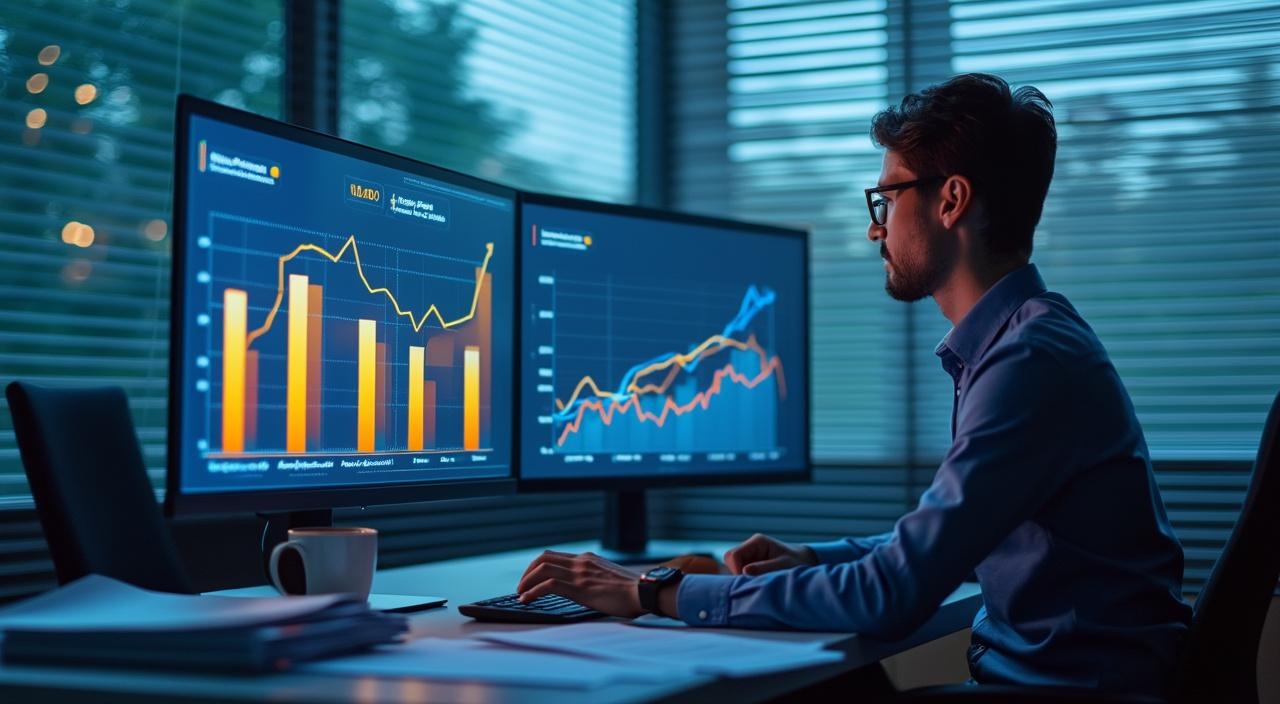
Future of Work: AI-Orchestrated Workflows
I’ve witnessed three decades of workplace evolution, from fax machines to smartphones. Nothing prepared me for what’s coming next.
The Productivity Revolution Takes Shape
By 2030, 65% of professionals will use AI-integrated digital brains. This isn’t speculation—it’s mathematical certainty based on current adoption curves. I remember when email felt revolutionary. Now we’re talking about AI systems that think alongside us, not just for us.
The exponential AI advancement we’re seeing today creates more adaptive workspaces than anything I’ve experienced in my business transformation career. Your office becomes fluid. Your tools anticipate needs. Your workflows adapt in real-time.
The Binary Big Bang Effect
What experts call the “binary big bang” is transforming productivity paradigms right under our noses. Higher creative output emerges when AI handles routine tasks. Reduced digital fatigue follows when systems integrate seamlessly.
Picture this: You wake up, and your AI has already prioritized your day based on energy patterns, meeting importance, and project deadlines. No more app-switching. No more context-switching fatigue. AI agents won’t replace you, but they’ll reshape how you work.
Strange but true: The companies resisting this shift will find themselves competing with organizations that operate at fundamentally different speeds. I’ve seen this pattern before during digital transformations. The gap widens quickly.
Entrepreneurs need survival strategies for this new landscape. The good news? Early adopters gain disproportionate advantages. Your digital brain becomes your competitive edge.
Sources:
• Sentisight.ai – AI Benchmarks Performance Soars in 2025
• Oxford Student – Artificial Intelligence
• The Journal – The Brain Drain: How Overreliance on AI May Erode Creativity and Critical Thinking
• The Collegiate Live – Using AI Changes Your Brain and It Might Be Ruining Everything
• Optimum Web – AI Agents and the Digital Brain: Key Insights from Accenture Tech Vision 2025
